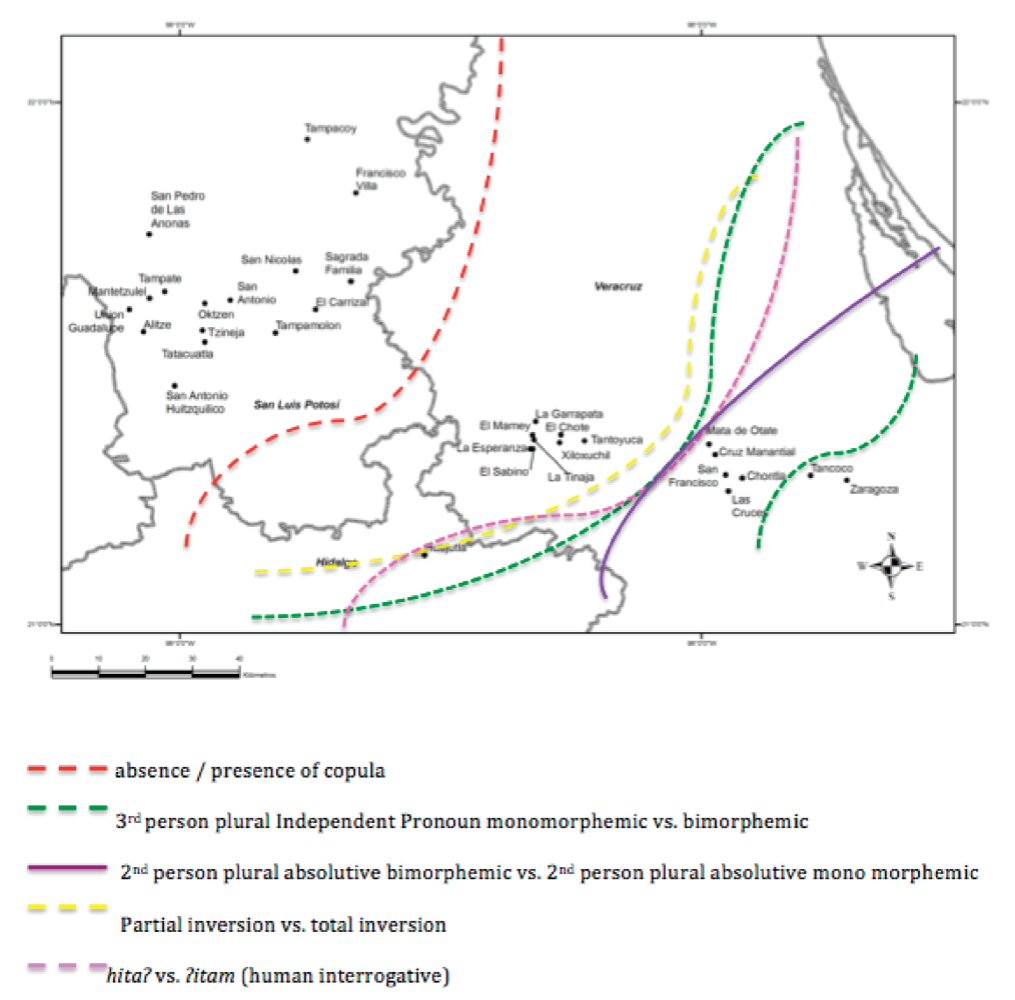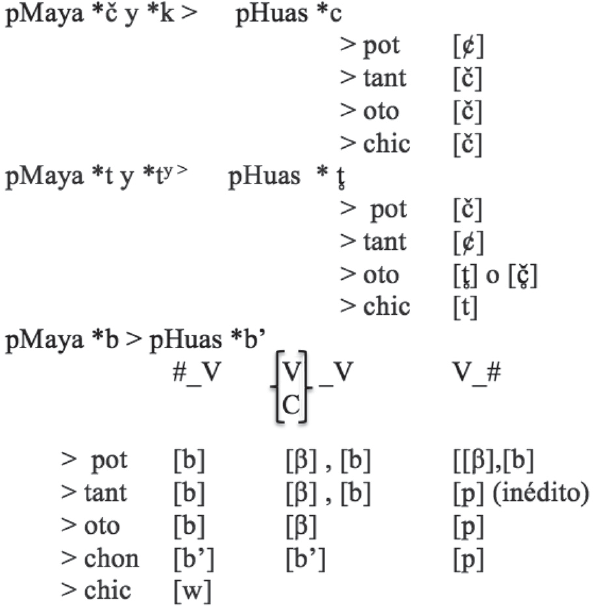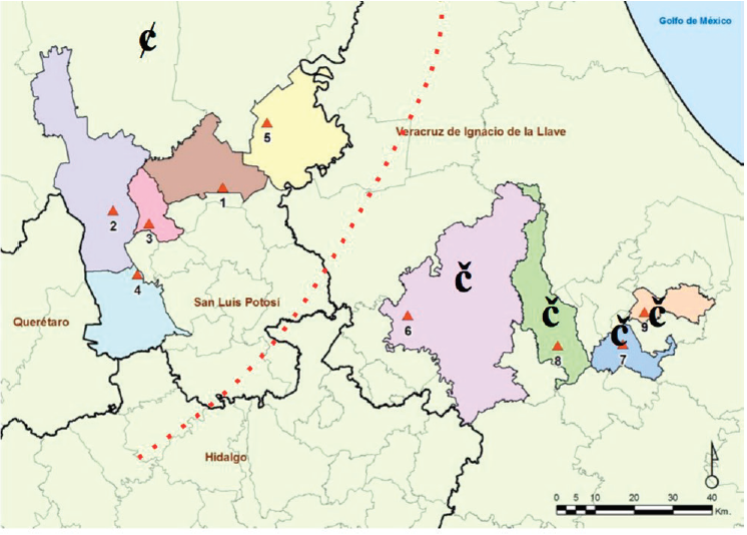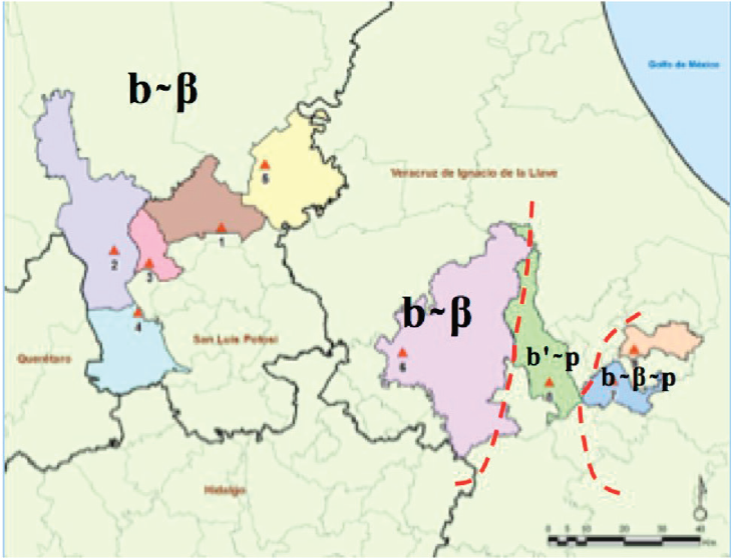1. Introduction
Huastec is a Mayan language spoken since pre-Hispanic times in the Huasteca region, far away from the rest of its linguistic family located in the "Mayan Region".1 The auto-denomination of Huastec language is teːnek, but this term is not used for practical reasons since "Huastec" is the name used in the academic field. It is spoken by an estimate of 167,000 people in the states of Veracruz and San Luis Potosí, Mexico, and although the absolute number could suggest that it is not endangered, most of the speakers in Veracruz are only adults and elderly people. Huastec is one of the Mayan Languages that have not been properly studied, and it also lacks pre-Hispanic written records. The oldest documents are three linguistic registers from Colonial times, which show the clear dialectal differences that existed among them.
In the Catalogue of National Indigenous Languages2 (2008), published by the National Institute of Indigenous Languages,3 it has been settled that Huastec has three dialectal variants, namely: Western or Potosino, Central (Tantoyuca region, Veracruz) and Eastern (Sierra de Otontepec, Veracruz), geographically distributed as shown in Map 1.
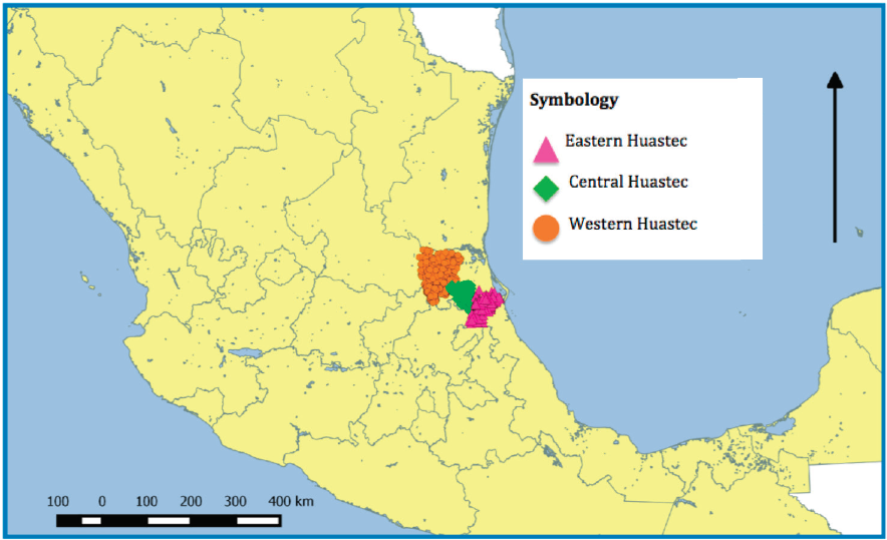
Map 1 Geographical Distribution of the Three Huastec Dialects According to CLIN (2008). Map by Perla Pisson Alcaraz (2016), based on data from National Institute of Statistics and Geography (henceforth, INEGI)
The idea to review the Huastec dialectal grouping presented by Kaufman (1985) arose after studying the morphological data of the person system that revealed an existing variation (Meléndez 2011, 2017). The overlap and divergence of isoglosses needed to be explained in order to describe the intra-dialectal variation attested in Eastern Huastec. The research focuses on the fact that some morphological features regarding the person system tend to overlap isoglosses in a regular way in the Central and Potosino dialects (see Map 2). This is an interesting fact when contrasted with the phonological level, in which varieties are clearly differentiated.
Besides the historical relevance of explaining the morphological tendency to group Central and Western dialects together, leading a specific intra-dialectal study in the Eastern dialect becomes even more relevant since it is a hugely endangered variety (Embriz and Zamora 2012: 36). Also, the Eastern dialect has barely been described: only one of the communities has been studied, but the rest are far from being documented (see San Francisco Chontla Grammar, Kondic 2012).
In view of the factors listed above, the present research shows new comparative work in order to reveal the features that overlap and those that differ among dialects and the preliminary results are presented as maps. 4 The intention of this research is not to propose a new dialectal grouping, but to reveal the current diversification in the Huastec language. These findings could be the basis for more academic research either in the field of dialectology or in the linguistic documentation of the variants, especially those that are seriously threatened and had not been yet described or documented. 5
2. Framework and Methodology
The framework of geolinguistics, or linguistic geography, is related to dialectology but instead of studying the dialectal grouping of a language using only phonology, it also deals with morphological and lexical variations in spoken languages. Geolinguistics also contemplates the factor of geographical space as one of the most important aspects to determine the linguistic variation within a specific language. Using this approach, data are obtained by semi-structured interviews and the variation data are organized into maps in order to create a linguistic atlas of a language. According to García Mouton (1996: 63), linguistic geography is not a science by itself, but a useful tool to study variations within spoken language. As Coseriu (1991: 102) states, linguistic geography is “un método dialectológico y comparativo [...] que presupone el registro en mapas especiales de un número relativamente elevado de formas lingüísticas (fónicas, léxicas o gramaticales) comprobadas mediante encuesta directa y unitaria en una red de puntos de un territorio determinado” [“A dialectological and comparative method […] presupposing the register, in special maps, of a relatively high number of linguistic forms (phonic, lexical, or grammatical) tested throughout a network of places in a determined territory through direct, unitary surveys”].
The survey net ("red de encuesta") for this study was collected during three different stages in nine Huastec communities, which cover almost the entire region where Huastec is currently spoken (see Table 1 and Map 3 for geographical location).
Table 1 Communities Selected for this Study
| Name of the Huastec communities | State |
| 1. San Nicolás, Tanlajás | SLP |
| 2. Mantetzulel, Aquismón | SLP |
| 3. Tamaletom, Tancanhuitz | SLP |
| 4. San Antonio Huitzquilico, Xilitla | SLP |
| 5.Francisco Villa, San Vicente Tancuayalab | SLP |
| 6. El Mamey, San Gabriel, Tantoyuca | Veracruz |
| 7. Tancoco, Tancoco | Veracruz |
| 8. San Francisco, Chontla | Veracruz |
| 9. Chinampa de Gorostiza | Veracruz |
The criteria to select these communities are: 1) that they have consistently shown some degree of grammatical or lexical variation with respect to each other in previous studies or, 2) guided by perceptual dialectology, that these are the areas with respect to which speakers declared to notice some kind of variation. The sample included one man and one woman from each of the nine communities, and although it was preferred that those speakers were between 35 and 50 years old, in some cases the only speakers left on the community were over sixty years old and the survey was applied to them. Regarding the questionnaires, two different lists were adapted and used:
a) Terrence Kaufman's list (ms.) for the phonological and lexical data, with a total of 460 entries. This tool was formerly designed to describe the dialectal variation of the Mayan languages in Guatemala in the early 70s.
b) Thomas Smith's list (ms.) for morphological and simple clauses, with a total of 435 entries.
3. Previous Research on Huastec Dialectology
Since Colonial times, friars noticed the Huastec dialectal variation and added a few notes in their texts; (see de la Cruz 1571: f.5) "y ansi para doctrina bre-ue no resta mas para que se enseñe con bendicion en toda la guasteca, pues de todos los pueblos della se tomo lo mas polido y conueniente de que vuestra señoria Reuerendissima la admita en seruicio" [And so, for a brief doctrine, nothing else but your Highness’ acceptance is necessary to teach it, with blessings, throughout the whole Huasteca region, because the most polished and convenient elements [of this language] were taken from each town”]
Tapia Zenteno (1767: 2) also claimed that:
Tendrá gran cuidado el principiante en no tropezar en el dialecto y pronunciación de los de Tamtoyoc, y la mayor parte de la jurisdicción de Tampico, excepto Panoco, que no la pronuncian como está dicho, mayormente los Serranos de Tamtima, sino que en lugar de la tz, usan en su lugar de ch pronunciandola como nosotros en castellano, y afectando un remilgo... [Beginners must be cautious not to stumble with the dialect and pronunciation of the Tamtoyoc people and most of those who live in the Tampico jurisdiction-with the exception of Panoco-who do not pronounce it as said, particularly those who live in the Tamtina Sierra; instead of the ‘tz,’ they pronounce the ‘ch’ as we do in Spanish…]
In her grammatical description of Xiloxúchil (Veracruz) Huastec, Ochoa (1984) concludes that Huastec has two dialects: Potosino and Veracruzano. Later, in 2007, Ochoa wrote some notes about Huastec dialectology and she suggested a new subdivision of the Veracruzano dialect into two "sub-dialects", i.e. Lomerío, and Serrano u Otontepec. She claimed that they were not different dialects; but, based on mutual intelligibility, they could only be considered as "sub-dialects."
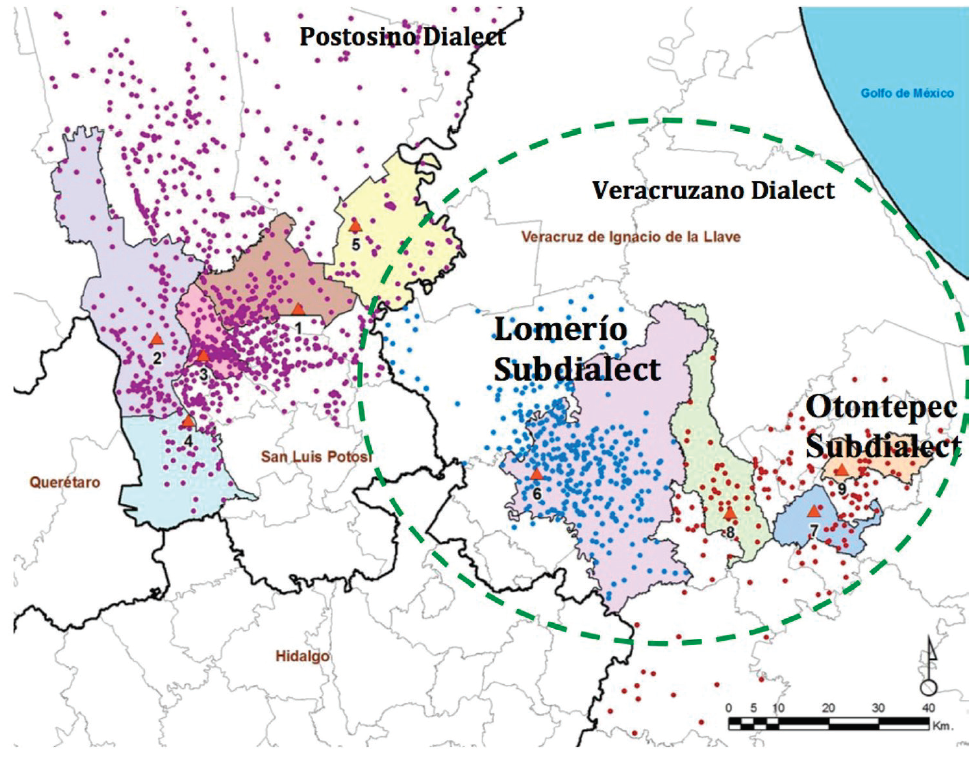
Map 4 Huastec Dialects Based on Ochoa (1984; 2007). Map by Oscar Zamora based on INEGI 2010 and CLIN 2008.
The first formal attempt to propose a dialectal study was Kaufman's brief article “Aspects of Huastec Dialectology and Historical Phonology” (1985). Based on the historical evolution of three phonemes summarized in Figure 1, he proposed that Huastec has three dialectal variants: Eastern, Central and Western6.
Kaufman's paper proposed that these three "non-uniform phonological traits found in Huastec" reveal the internal relations among the Huastecan languages. Kaufman concludes that Huastec dialects differentiated very recently (around 400 years ago), since most of the loanwords from Nahuatl and Spanish into Huastec show evidence of recent evolution in the different dialects. One of Kaufman’s most important contribution was the "official"recognition of the Eastern Huastec as a well-differentiated dialect, which until then had been seen as part of a bigger single dialect called "Veracruzano".
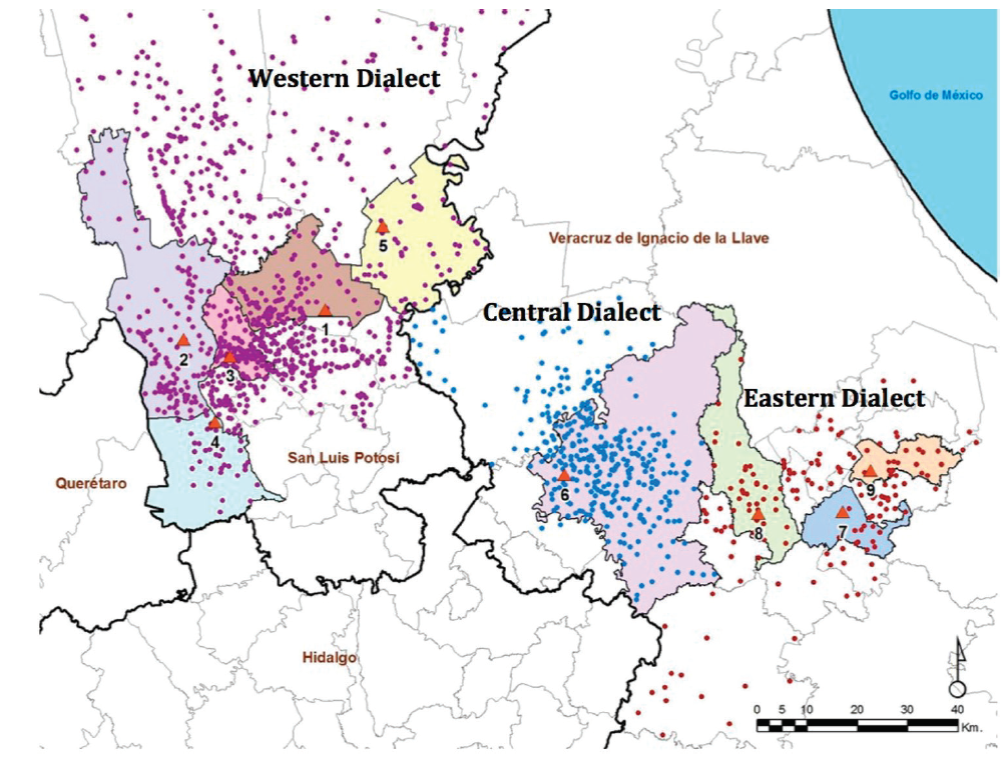
Map 5 Distribution of Huastec Dialects Based on Kaufman (1985). Map by Oscar Zamora based on INEGI 2010 and CLIN 2008.
In 2008, INALI published the Catálogo de las Lenguas Indígenas Nacionales [Catalogue of National Indigenous Languages], where it was officially stated that Huastec features the three dialects proposed by Kaufman (1985). The geographical distribution of these three dialects is shown in Maps 4 and 5, with different color dots: purple for the Western dialect, blue for Central dialect and red for the Eastern dialect. Two years later, Meléndez (2011, 2017) noticed that the Eastern dialect presented morphological variation that could lead to a new subdivision: Tancoco speakers (#7) and San Francisco Chontla (#8) speakers differentiated in various morphological features. On the other hand, she observed that Central and Western dialects share recent innovations in the morphological level and this issue needed to be explained since they clearly differ in the phonological level.
Phonological features are the most common criteria to propose a dialectal grouping, since phonology is highly regular. Nevertheless, new attempts to include other grammatical levels have shown more variation than previously thought, leading to a finer view of a particular type of language diversity. In Huastec, the best-known isoglosses relate with the evolution of the proto-Huastec phoneme *c into the different current variants. This diversification was noticed during the 18th century by Tapia Zenteno (1767), and later described by Ochoa (2007) and Kaufman (1985) in their work (see Map 6 for the reflections of this phoneme in the different Huastec dialects).
The second phonological isogloss is related to the evolution of the affricate retroflex */t̥/, as shown in Map 7.
And, finally, the isogloss that refers to the evolution of the proto phoneme */b'/, as exhibited in Map 8:
As Kaufman (1985) realized, Chontla seems to be very peculiar in its linguistic development compared with the rest of the dialects, including other communities located in the Sierra de Otontepec region. After an analysis of the particularities that Kaufman found in Chontla, and the author’s phonological research, some variations were found between Tancoco (#7), Chinampa de Gorostiza (#9) and Chontla (#8). In other words, Eastern Huastec does not behave as a regular dialectal unit, and this diversification needs to be explored in further studies.
Beyond phonology, and in the light of the variation attested in morphological, lexical and syntactical levels, it is necessary to perform an intensive research to describe current Huastec variations. In order to clarify the scope of this variation, some research was done from 2014 to 2016 in the project "Documentación lingüística del Huasteco." Some of its preliminary data are presented in this paper; nevertheless, results are not conclusive. This information is shared in order to encourage more sociolinguistic studies, so as to find a more accurate perspective on Huastec dialectology.
4. Eastern Huastec New Isoglosses
4.1 The phoneme /l/ corresponds to /n/ only in Tancoco, in some specific items
One of the differences observed exclusively in Tancoco (#7) refers to the segment /l/, which in Tancoco is attested as /n/ in word-final contexts in some specific lexical items, but not in the rest of the communities, as distributed in Map 9.
Table 2 Some examples that show the correspondence of /n/ in word-final context in Tancoco whereas the others have /l/
| ITEM | TCO | CHIP | SFC |
| ‘it's on the edge’ | k’ʷahat tin waːn | k'ʷahat tu wal | k'ʷahat ti b'aːʔ teːʔ |
| ‘he eats’ | hayun | k'apuw | hayul |
| ‘it's in the middle’ | k’ʷahat tam čehen | kʷa tam č'ehel | k'ʷahat tam č'ehel |
| ‘rainbow’ | pič'an | pič'al | pič'al |
| ‘sea’ | puhan | puhal | pulik ˈhaʔ |
The origin of this particular change is not clear to me since it only affects the segment /l/ in word-final contexts in specific lexical items, but it is not extended as a regular change in the whole system. Nevertheless, it tends to occur in a regular way with both the persons consulted (male and female) of Tancoco, which shows that this is not a phonetic alternation. This is not an isolated feature that distinguishes Tancoco from San Francisco, as it will be shown later.
4.2 Vocalic Alternation of /a/ ~ /o/
One phonological change found in San Francisco Chontla (#8) that clearly contrasts with Chinampa de Gorostiza (#9) and Tancoco (#7) is the vocalic alternation of the vowel /a/ in some lexical items, which has changed to /o/ only in San Francisco but not in the other two (see Table 3 and Map 10)
Table 3 Phonological /a/ Is Performed as /o/ in SFC, Contrasting with CHIP and TCO
| Lexical item | TCO (7) | CHIP (9) | SFC (8) |
| ‘walking stick’ | kʷajap | kʷajap | k'ojop |
| ‘he listened’ | ʔač’aʔ | ʔačʼaʔ | ʔoč'oš |
| ‘anyone’ | šawaːkič | hawaʔkič | šowaːkič |
This feature belongs to the phonological sphere, since it is not restricted to a particular context and because it is regular, given that the alternation is always between these two vowels. It is not an absolute rule that every /a/ will become an /o/ in San Francisco and in that sense this change is apparently linked to specific lexemes.
4.3 Some other vocalic alternations in Tancoco, San Francisco Chontla and Chinampa de Gorostiza
There is a group of lexical items that present diverse types of alternation in the syllabic nucleus and, in some cases, the loss of a syllable. Clearly, some of the vocalic alternations are phonetically motivated by being adjacent to a palatal consonant-for example-but this is not as systematic as it could be expected.
Even though there is not a rule that determines the occurrences of these vowel alternations, they should be mentioned since they belong to the diversification that is currently taking place in this group of communities that has traditionally been considered a single dialectal unit (see Table 4 for examples of it).
Table 4 Vowel Alternations between Communities that Belong to Eastern Huastec
| LEXICAL ITEM | TCO | CHIP | SFC |
| ‘female turkey’ | potoč | putuč | k'aθaːw |
| ‘like that’ | ʔančanaːʔ | ʔančeːʔ | ʔinčanaːʔ |
| ‘my bone’ | nu beklek | nu beklek | nu beklak |
| ‘nine’ | beleːho | beleːho | beleːhu |
| ‘this one’ | ʔešeːʔ | ʔašeːʔ | ʔašeːʔ |
| ‘eight’ | wašek | wašik | wašik |
| ‘ten’ | laːho | laːhu | laːhu |
| ‘warm’ | mamomuːl | mamumuːl | mamušː |
| ‘beautiful’ | ʔalbeːl | ʔalabeːl | ʔalobeːl |
| ‘today’ | šeweːʔ | šoweːʔ | šuweːʔ |
| ‘I know him’ | nan ʔu ʔešloːʔ | nanaːʔ u ʔešlaːl | nanaːʔ u ʔešlaːl |
| ‘boy’ | čakam | čakam | čikam k w itoːl |
| ‘honey’ | čiːmal ʔi čapča | čiːmal ʔi čapt̥om | čiːmal ʔi čapt̥am |
| ‘rope’ | laːθo | laːθu | laːθu |
| ‘poor’ | č’ewentaːl | č'ontaːl | č'ontaːl |
As can be seen in Tables 2, 3 and 4, the three communities studied here show some degree of variation in the phonological level. As mentioned before, Kaufman (1985) had already noticed that Chontla seems to have a different evolution compared to other Huastec communities. Kaufman focuses specifically on the use of the phoneme /b'/ in Chontla, which is the only community that carries on the reflection of the proto-Mayan */b/. The data presented here reinforce the idea that there is a greater diversification at this grammatical level as it is clear that although the variation seems negligible it cannot be ignored.
4.4 Lexical Variation in Eastern Huastec
At the lexical sphere, the data tend to support a greater diversification of Eastern Huastec (see Tables 5, 6 and 7 below).
Table 5 Distinct Lexical Items in the Eastern Huastec Communities Studied
| ITEM | TCO | CHIP | SFC |
| ‘who’ | hišti | hitaʔ | tamaːʔ |
| ‘what’ | hišti ~ hont'o | hont'o | toneːy |
| ‘which house’ | hišti ʔin k'imaːʔ | hawaʔ in k'imaːʔ | huːn tana ʔataː |
| ‘another’ | ʔiš nahaːʔ | ʔanuːʔ | nuːwaʔ |
| ‘nothing’ | baːšataʔ | baʔtaʔ ~ yaba hata | b'a tantoː |
| ‘pinole’7 | pinoːl | moʔoθ | poːθ k’apneːl |
| ‘maize tamale’ | t’uːθ k'oyeːʔ | kʷitoːm | muluč |
| ‘bed’ | waytalaːb | waytal | čeyil |
| ‘rich man’ | riko | koʔol ʔan meːlu8 | meːluliθ |
| ‘grandfather’ | maːm9 | ya taːtaʔ | pulik paː |
| ‘flat’ | biliːy | ʔoliθ~ʔoliliːh | b'aθiθiːl |
The items in Table 5 show a tendency to isolate the three communities; nevertheless, the data in Table 6 and 7 exhibit a grouping where, most of the times, San Francisco and Tancoco show clear differences, whereas Chinampa de Gorostiza groups with any of them (see below):
Table 6 Lexical diversification that tends to group CHIP with TCO, and differentiate them with respect to SFC
| ITEM | TCO | CHIP | SFC |
| ‘hat’ | sombreːr | sumbreːl~ somˈbreːl | koʔalaːp |
| ‘how’ | hont'oːn ti | hont'o ni | toneːj |
| ‘why’ | halištiː | halešti | ni tiːʔ |
| ‘parrot’ | loːɾo | loɾo | kiʔaːm |
| ‘water snail’ | kaɾakol ~ ʔukul an haːʔ | ʔukul | šoːč |
| ‘elbow’ | totočel~tutučil | tutuːč~koːdo | tiyiːkʰ |
| ‘arrow’ | fleːča | fleːča | t̥it̥oklaːp |
| ‘scissors’ | tiheːɾas | tiheɾaʰ | kašuštalaːp |
| ‘mattock’ | ʔasadoːn | ʔasadoːn | čišimtalaːp |
| ‘basket’ | toknal | toknal | taknaːp |
| ‘jícara (gourd bowl)’ | kʷentoː ~kʷentu | tuʔ~ kʷentu | ušnap tuˀ |
| ‘skirt’ | ʔakištalaːp~ nawa | ʔalkistal | lakapʰ |
| ‘mother’ | naːna | naːna | miːm ~ maː |
| ‘father’ | papaː ~taːta | taːta | pajloːm ~ paːʰ |
| ‘to bite’ | čaʔuš | čaʔuš | k'atuš |
| ‘to cut with an ax’ | šilaːʔ | šilaːʔ | pokoʷ |
| ‘food’ | tolaːp | tolaːp | k'apneːl ~ teʔneːl |
| ‘to swim’ | kowal | kowal | laːt̥um |
| ‘small’ | čekat ~ čikat | čikat | čipiːl |
| ‘ugly’ | k'ak'aθ | k'ak'aθ | ʔatašič |
| ‘to be seated’ | bušuːl | bušuːl | k'ʷahat |
| ‘wet’ | ʔaːč' | ʔaːč' | čabaθ |
| ‘thanks’ | hikpat̥ | hikpat̥ | halbinčiːč |
| ‘to pursue’ | ʔaθinθaːl | ʔaynaːl~ʔaθinθal | pahnaːl |
Table 7 Lexical diversification that tends to group CHIP with SFC and to differentiate them with respect to TCO
| ITEM | TCO | CHIP | SFC |
| ‘sin’ | ʔataštalaːp | walap | walap |
| ‘sandals’ | waɾače | pahap~ waɾaʧo | pahap |
| ‘zanate’ | kʷerbo | č'ok' | č'ok' |
| ‘nigua’10 | tikiliːy | ʔočel č'ak | ʔočel č'ak |
| ‘wooden spoon’ | kučaradeteʔ | kuʧaɾa ~weweθtuʔ | weweθtuʔ |
| ‘water container’ | češiktu ~ mul | wit'iːm | wit'iːm |
| ‘kinsman’ | ʔebt̥aːl | haʔuːp | haʔuːp |
| ‘to know’ | ʔešlaːl~witaʔ | čoʔoːp | čoʔoːp |
| ‘to hate’ | čakun | tilibnaːl | tilibnaːl |
After comparing the lexical data in Tables 5-7, San Francisco, clearly, has more Huastec words whereas Tancoco and Chinampa exhibit more Spanish loans. Although I have grouped Chinampa and Tancoco in Table 6, and Chinampa and San Francisco Chontla in Table 7, I do not want to imply that the loan matches are due to shared changes but simply to point out the variation that currently exists between them and the complexity of grouping in one or two dialects in light of the discrepancies found.
In this sense, the presence of Spanish loans in Tancoco and Chinampa is not necessarily anchored to the same historical moment, since the words for 'wooden spoon' or 'sandals' present synchronic alternation of the Huastec word and the Spanish loan in Chinampa but not in Tancoco, where it is only attested the Spanish loan. It means that loanword matches between Tancoco and Chinampa could have pass to Huastec in different historical moments and, consequently, are not shared changes. In terms of diachronic variation, this fact suggests that Spanish-Huastec contact has been more intense in Tancoco than in Chinampa, and less intense in San Francisco.
A possible explanation for the lexical matches shared by Chinampa and San Francisco Chontla could rest on geography: CHIP is located in the middle of the state freeway connecting Chontla-Naranjos. This has allowed the residents to keep commercial and cultural exchange,11 which would explain the lexical borrowings between these two communities.
On the other hand, Tancoco is geographically isolated from the other communities, which would explain the lack of similarities. The absence of current interaction among the communities would explain that most of the lexical matches between CHIP and TCO may be traced to pre-Hispanic or Colonial times.
The idea of independent recent evolution of Tancoco apart from Chinampa-and, seemingly, apart from Chontla, too-is supported by other grammatical traits beside the lexical data, which reveals Tancoco as the most innovative of the eastern Huastec group. Also, it supports the idea that San Francisco Chontla is the most conservative Huastec-speaker community, not only regarding to phonology but also in the lexical sphere.
4.5 Distribution of the different negation words in Eastern Huastec
A last issue regarding lexical variation is related to the distinct negative words registered: SFC, CHIP and TCO exhibit different negation morphemes. See examples 1-3:
1. ʔan čakam yabaʔ ø=neʔeč 12ti doctoːr
DET boy/little NEG ABS3=become PREP doctor
‘The boy will not become a doctor’ (CHIP)
2. ʔan čikam k w itoːl b’ap ø=neʔeč ti ʔilaːliš
DET little boy NEG ABS3=become PREP doctor
‘The boy will not become a doctor’ (SFC)
3. ʔan čakam ʔibaːč ø=neʔeč ti doctoːr
DET little/boy NEG ABS3=become PREP doctor
‘The boy will not become a doctor’ (TCO)
As shown in Map 11, each of the communities that belong to Sierra de Otontepec have different negation markers. On the contrary, the Central dialect (Tantoyuca, Veracruz) and those Huastec speaker communities located at San Luis Potosí (i.e. Western dialect) share the same negation mark, yab.
The negative lexemes attested in Huastec are very different to the lexical form reconstructed by Kaufman and Justeson (2003: 1531) in proto-Mayan *ma, and to the negative words attested in the rest of the Mayan languages. Huastec preserved the vowel /a/ and, possibly, the bilabial feature of the proto-Mayan negation marker. Considering that the prototypical Mayan root structure is CVC, proto-Huastec form could had been *b'ap, and the other lexical forms are derived from this.
4.6 Alternation of absolutive third person in Eastern Huastec
As a regular head-marking language, Huastec marks the different arguments of the verb through person morphemes in the verb. In most of the communities, the absolutive third person is expressed as a zero morpheme, except in SFC, where the consistent marking of 3rd person plural absolutive marker is Vb’, as exemplified in 4-6:
4. babaːʔ ø=waʔč-i-n
3PL ABS3=to be born-inac-mpass
‘They were born’ (CHIP; Ver)
5. b'ab’aːʔ ʔub’=waʔč-i-n
3PL ABS3PL=to be born-INAC-MPASS
‘They were born’ (SFC; Ver)
6. hahaːʔt̥ik ø=waʔ-č -i-n
3PL ABS3=to be born-INAC-MPASS
‘They were born’ (TCO; Ver)
The proto-form was reconstructed as *ib by Meléndez (2011: 192), nevertheless the form could have been *ib' considering the Kaufman and Norman's (1984: 91) reconstruction in proto-Mayan as **eb', and also according to the phonological system presented by Norcliffe (2003) for proto-Huastec. The alternation of the vowel from /u/ to /i/ in the speaker community of San Francisco Chontla is explained as a regular alternation motivated by a process of vowel harmony that occurs with person markers (see Meléndez 2011 for a deeper discussion on this issue).
4.7 Variation of Syntactic Features in Eastern Huastec
There are different morphological features associated to the person system (see Meléndez 2011; Meléndez, 2017), as well as other relevant syntactic features.
a) It is a strict Huastec syntactic rule that the determiner position in a noun phrase must be always overt; i.e. no bare nominals are allowed as noun phrases. However, there is a weakening in the marking of the definite determiner in TCO (example 7) with respect to SFC and CHIP, whereas the last two keep the syntactic marking of the determiner in every context, as exemplified in 8:
7. ʔan pik’oʔ ø=k' w ahat ʔan ti wiːʔlep ø ʔataː
def dog ABS3=to be.cp def prep door house
'The dog was at the door of the house' (TCO; Ver)
8. ʔan pik’oʔ ø=k' w ahay ʔan t=in pikib ʔan ʔataː
def dog ABS3=to be.icp def prep=pos3 front def house
'The dog is at the door of the house' (SFC; Ver)
The weakening of the determiner occurs as well with the indefinite determiner, as in example 11 (in contrast to 9 and 10):
9. ø=koːʔol huːn ʔi laktem ʔan ʔu k'imaːʔ
ABS3=to.have one INDEF chair def pos1s home
'He has a chair at my home' (chip; Ver)
10. ø =waʔač huːn ʔi laktem ʔan ti ʔataːʔ
ABS3=there.is one INDEF chair DEF PREP house
'There is a chair at the house' (SFC; Ver)
11. waʔač huːn ø laktem ʔan ti ʔataːʔ
ABS3=there.is one chair DEF PREP house
'There is a chair at the house' (TCO; Ver)
b) Another syntactic feature that shows a divergence from Chinampa de Gorostiza compared to San Francisco and Tancoco is the syntactic structure of human-interrogative sentences. These kinds of sentences differ as follows: chip has [INT+ tin + FN] whereas TCO and SFC have [int+ fn]; examples 12-14 illustrate this feature:
12. ¿ hitaš tin t’ohliš ?
who ? major
‘who is the major?’ (chip)
13. ¿tama ʔan t’ohliɵ?
who def major
‘who is the major?’ (SFC)
14. ¿hišti ʔan aheːnte?
who def major
‘who is the major?’ (TCO)
The meaning and syntactic function of the morpheme tin in sentence 12 is not clear, since it is not attested in other Huastec variants, but in Chinampa it tends to occur frequently in interrogative sentences. However, it is interesting that this innovation occurred just in Chinampa, where the language is barely spoken by only a few elderly Huastec speakers.
Another innovation attested in Chinampa is the tendency to use complex verbal forms (nominalizations) whereas TCO and SFC tend to use simple verbal forms, see 15-17:
15. babaːʔ ʔešom ʔan ti t’ohnal
3PL PROGR DEF PREP work
‘They are working (now)’ (CHIP; Ver)
16. b'ab'aːʔ ʔešom t=ub’ t’ohnal
3PL PROGR DEF PREP=ABS3pl work
‘They are working (now)’ (SFC; Ver)
17. hahaːʔt̥ik ʔešom ti ø=t’ohnal
3PL PROGR DEF PREP ABS3=work
‘They are working (now)’ (TCO; Ver)
5. Central and Western Huastec: overlapping and Divergent isoglosses
The Central dialect is spoken in the communities located in the Tantoyuca municipality (Veracruz) and its surroundings, and it clearly exhibits particular grammatical features that diverge from the other dialects. As previous linguistic studies have pointed out, the major differences between Western and Central pertain to the phonological sphere and are related to the distribution of the phonemes /ȼ/ and /č/ in lexical items that clearly diverge from the other dialects (see Kaufman 1985; Ochoa 2007; Herrera Zendejas 2014).
The Western dialect is, geographically and numerically, the most widespread variant. It extends from the Xilitla and Aquismón Sierras (SLP) to the plains region adjacent to Veracruz. It is the only variant that has gained new spaces of use13 instead of losing them, a factor that strengthens the vitality of the language.
The matches between both dialects belong mainly to the morphological sphere. In the person system studied by Meléndez (2011, 2017) it is shown that they share one of the most important innovations of Huastec: they have reduced one structural position in the verbal phrase, marking only one of the two participants of transitive sentences. In the person system, they share as well the bi-morphemization of most of the morphemes that belong to this sphere (personal pronouns are bi-morphemic; the second and third person of ergative and absolutive sets are systematically bi-morphemic as well). The overlapping isoglosses are shown in Map 12.
The data show that the Central and Western dialects are phonologically differentiated. However, there are similarities both in their verbal structure and in morphological features related to person markers (the red and purple isoglosses in the Map 12 represent morphological similarities of this otherwise clearly different dialects). These similarities could be explained by three different causes: a) as a product of recent common evolution, b) by autonomous parallel evolution or c) by contact-induced recent innovations. Common evolution is not the most viable explanation, since the phonological divergences are the most ancient traits that produced the split into the current variants and these are not shared in both groups. Independent parallel evolution could be a possibility if the typological tendencies were common in other languages, but they are not. Contact-induced recent innovations could be the most optimal explanation, since the communities probably have maintained regular contact in the more recent history. This could explain the matches that exist in the lexical sphere and the clear differences with respect to the communities located in the Otontepec Region, in which Central Huastec speakers have clearly maintained themselves isolated. This particular topic needs to be explored in a specific work but it goes beyond the scope of the present study.
6. Discussion
Based on lexical and phonological data, Kaufman suggested that the differentiation between the Huastec dialects occurred in recent times. This fact is relevant for this research since it is clear that Huastec dialect diversification is not anchored to a remote past and that makes a significative difference with respect to other Mesoamerican languages, like the Otomanguean languages, for instance, where diversification is so antique that they have evolved into different languages. Although it is undeniable that the variants are well differentiated as discrete entities, they show a recent evolution that is still in progress, given that it is possible to observe synchronic alternations in some morphemes, phonemes and lexical items. In this sense, there are at least three dialectal variants of Huastec, but the evolution attested within Eastern Huastec deserves a deeper look into the evidence. Then, the question arises: how different two speaker communities need to be in order to be considered different dialects, or even different languages? The answer is not properly a linguistic task, but it can be useful to understand the current variation and its applications for practical or political matters. San Francisco, Chinampa and Tancoco have shown differences that must not be ignored; if they cannot be considered different dialects, the variation of the grammar levels between Tancoco and San Francisco Chontla should be enough to study them independently (at least linguistically).
The communities located in Sierra de Otontepec have more reflections of proto-Huastec than those located in Tantoyuca, Veracruz, and in the State of San Luis Potosí. The Sierra de Otontepec speakers, in towns like San Francisco, seem conservative compared with speakers from Tancoco and Chinampa, who are innovative, even when Huasteco speakers are in their sixties or older.
Another question arises: why are these variants changing even when the language is not being used? There is no obvious explanation for the fact these changes are happening in less linguistically-vital communities (Tancoco and Chinampa), as well as in communities where the language is widely spoken (San Luis Potosí).
The intra-dialectal morpho-syntactic differences in the Otontepec or Eastern Huastec are remarkable and they contribute to separate it into three different groups, considering that their internal differences are systematic in other grammatical levels (CHIP, TCO and Chontla). Finally, the morphosyntactic differences in the Western or slp dialect are subtler than in the Eastern dialect: this is interesting since their geographical distribution is very extensive compared with the Otontepec dialects; but, nevertheless, it seems to conserve many shared grammatical features between all the speaker communities that belong to this dialectal group.
Some theories try to explain this complex sociolinguistic variation based on the fact that Sierra de Otontepec remained isolated from the rest of the Huastec-speaking communities. Also, San Francisco Chontla is separated, both geographically and socially, from Tancoco as there is not a road or social system connecting their inhabitants.
It is not surprising that San Luis Potosí has so many dialectal innovations, as it is the most widespread Huastec dialect, with a high linguistic vitality. An important feature to underline is the recent morphological innovations shared with the Central dialect, which is clearly differentiated in phonological matters. These innovations must be recent, because they are not attested in Tapias Zenteno’s registry from 1767, and they some show synchronic alternation.











 nueva página del texto (beta)
nueva página del texto (beta)

